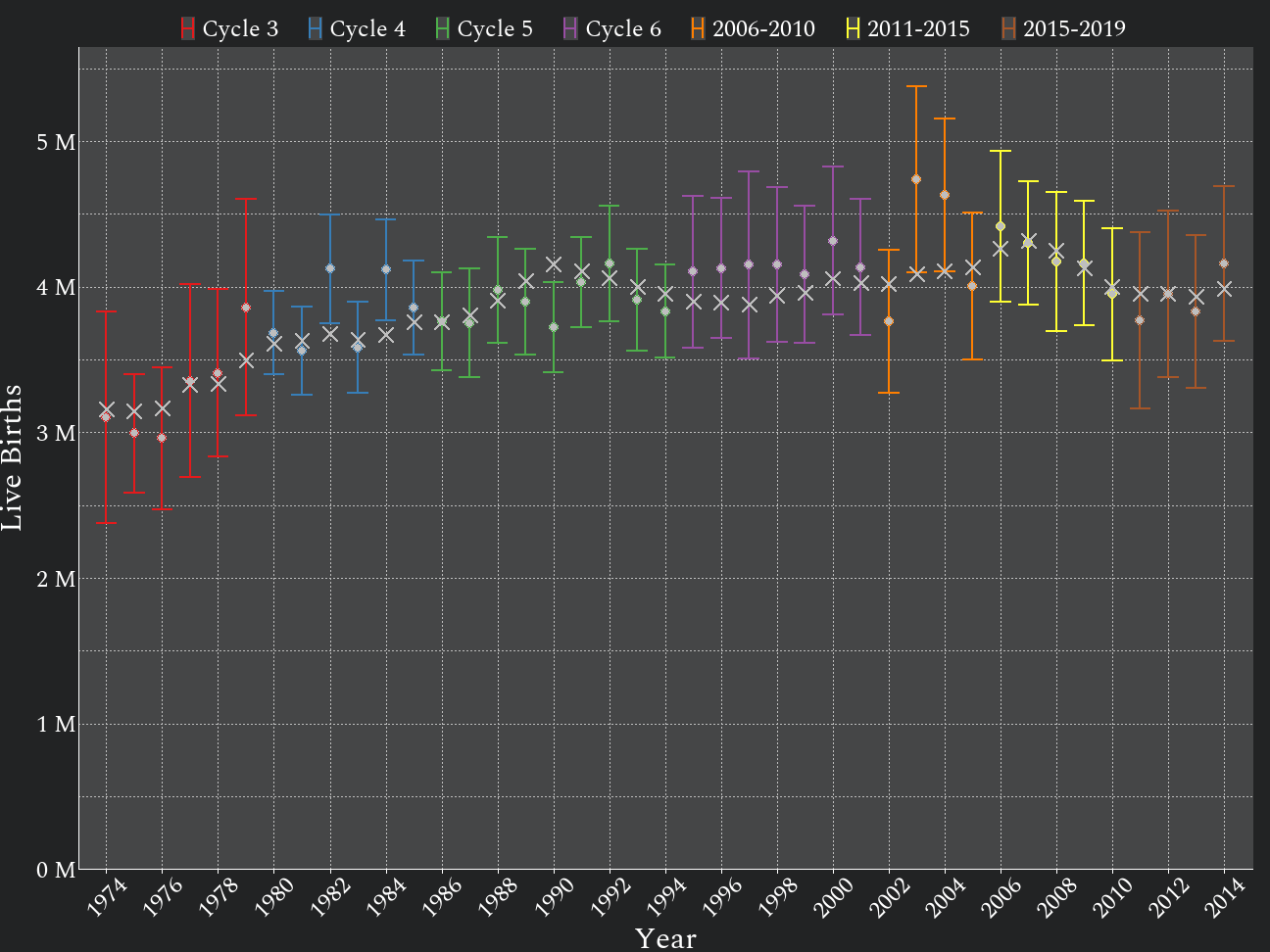Abortion Under-Reporting on the National Survey of Family Growth in Two Plots
Estimates of abortions from the NSFG are about a third of the true numbers.

The National Survey of Family Growth (NSFG) is a survey administered by the National Center of Health Statistics (NCHS) and is the United States’ premiere fertility survey, providing insight into pregnancy intent, frequency, and outcome, among other topics. The National Vital Statistics System (NVSS) is also administered by the NCHS and collects birth and death certificate data from the several states of the United States.
The NSFG is a survey given to a randomized sample of between 8,000 to 23,000 respondents, depending on the particular iteration of the survey. The NVSS is effectively a census of all live births in the United States.
If the NSFG is accurate, estimates from the NSFG should match the census counts from the NVSS. In Figure 1, we can see that this is the case.
The X’s in Figure 1 represent the number of live births in the United States in a given year taken from the NVSS, and the brackets with a circle in the middle represent 95% confidence intervals for estimates of live births in a given year calculated from the NSFG. As we can see, most of the 95% confidence intervals from the NSFG cover the corresponding year’s NVSS count of live births.
The various colors of the brackets in Figure 1 represent which iteration of the NFSG the estimates are taken from. Based on my review, the NSFG produces accurate estimates of live births for the five to ten years before each survey iteration. Birth estimates become less reliable for years father back before the survey because more and more birth mothers have either died or aged out of the target population of the survey the longer the time period between birth and survey.
Cycles 1 and 2 of the NSFG are not included in Figure 1 because they only surveyed women who had ever been married. These iterations missed all of the unintended pregnancies that occur among never-married women and so are not suitable for the study of reproductive responsibility.
With a few aberrations, we can see that the NSFG does a decent job with live birth estimation. The circles in Figure 1 tend to follow the X’s, and the brackets usually contain the X’s.

On the other hand, the NSFG does not do a good job of estimating the number of induced abortions per year in the United States. While data on abortions in the United States are quite poor generally, the X’s in Figure 2 are taken from the Guttmacher Institute’s Abortion Provider Census (APC), which typically reports the greatest number of abortions among abortion surveys and probably has the closest estimates to the true number.
As we can see, the estimates of the number of induced abortions based on the NSFG are routinely less than half the number reported by the APC.
The goal of my weight adjustment project is to make the estimates of induced abortion from the NSFG match external counts from the APC by increasing the weights of those respondents who report one or more induced abortions. This is not, of course, done as a brute force arithmetic adjustment. Care has to be taken so that other estimates, such as the total number of women in the United States and the total numbers of births by various demographic categories, remain accurate.
References
“Appendix 2: Topic-Specific Notes for 2017-2019, NSFG User’s Guide.” 2021. National Center for Health Statistics. https://www.cdc.gov/nchs/data/nsfg/NSFG-2017-2019-UG-App2-TopicSpecificNotes-508.pdf.
Desai, Sheila, Laura D. Lindberg, Isaac Maddow-Zimet, and Kathryn Kost. 2021. “The Impact of Abortion Underreporting on Pregnancy Data and Related Research.” Maternal and Child Health Journal 25 (8): 1187–92. https://doi.org/10.1007/s10995-021-03157-9.
Lindberg, Laura, Kathryn Kost, Isaac Maddow-Zimet, Sheila Desai, and Mia Zolna. 2020. “Abortion Reporting in the United States: An Assessment of Three National Fertility Surveys.” Demography 57 (3): 899–925. https://doi.org/10.1007/s13524-020-00886-4.
